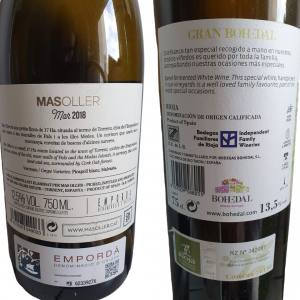I seem to get asked the questions «why does my wine smell fruity?» or «where do all of these aromas come from?» quite a lot, hence this post.
Hopefully when you’ve finished reading this you’ll have a much better understanding of where all those fruity, oaky, minerally aromas actually come from in your wine. And if not, your head will be buzzing with a million more questions and a tonne of wine vocabulary (win-win!)
Detecting and describing aromas in wine can be difficult, even for the pros! The first incial smell can be so overwhelming that we send our minds into overdrive and eventually, block the senses so that we can’t identify anything at all. But it’s important to remember that aromas can be split up into 3 important sections:
- Primary aromas
- Secondary aromas
- Tertiary aromas
Now you’re asking me… What is the difference between these 3 categories?
PRIMARY AROMAS
These are the ones that appear in your wine after the alcoholic fermentation has finished. Some of these come from the grapes themselves and others are created during the fermentation process.
The majority of primary aromas are fruity, but there are also herbaceous and herbal aromas such as grass, tomato leaf or lavender and eucalyptus. And of course the spicy aromas of black pepper, liquorice…
SECONDARY AROMAS
These come from the post-fermentation process that happens to a wine. They can come from the most obvious barrel ageing (adding vanilla or oaky aromas to the wine); from malolactic fermentation (adding characteristics like butter or cream) or from yeast autolysis or lees contact (adding yeasty or biscuity aromas to the wine).
TERTIARY AROMAS
These aromas appear during the ageing process that the wine undergoes. For example, the process could be oxidative (a long period of time in oak, for example) and could cause aromas like toffee, caramel. Or, we could find aromas such as petrol, honey, mushroom caused by bottle ageing – protected from the action of oxygen.
So how do you detect the primary, secondary and tertiary aromas in wine? And how do you know the difference between them?
Normally when you try wine you can read the label on the bottle. this will give you some information as to what to expect. Let’s look at a practical example…

The above picture shows 2 (very good!) white wines – a Mas Oller Mar from the DO Empordà and a Gran Bohedal fermented in oak from La Rioja. Just by looking at these labels you can more or less identify a few aromas in the wines:
MAS OLLER MAR looks like a young wine, so we should expect to find fresh, fruity primary aromas. Maybe some citrus notes or some herbaceous flavour. We don’t know which variety of grape it’s made from yet so we can’t make any more guesses.
The GRAN BOHEDAL label tells us that it’s fermented in barrels so we can have a guess at some secondary aromas in this case: vanilla, smoke, butterscotch maybe?
When we turn the bottles around to look at the rest of the label, we get a lot more information…

The MAS OLLER BLANC is from 2018 and the label doesn’t state that it has been bottle or barrel aged so we can guess that the main aromas will be primary here.
Fruity flavours like citrus (lemon and lime), tropical fruit like pineapple or passion fruit.
The GRAN BOHEDAL tells us that the wine is fermented for 4 months in oak, so we will expect to find some secondary aromas in this case (vanilla, smoky flavours maybe?) but also, it’s been aged for 2 years in the bottle.
In this case, most of the fresh fruity primary aromas will have developed into marmalade, dried fruits and we will probably find some nutty, toasty aromas too from bottle ageing.
When you taste wine, it’s important to remember these 3 categories so that you can identify aromas and flavours in an organised way. By doing this every time you taste you will eventually be able to identify aromas easily and won’t hesitate in believing yourself!
Sign up to my newsletter for a free tasting wheel in English! An unbelievably full wheel of tasting lexicon for you to put into practice in your wine tastings!

3 thoughts on “Classifying aromas in wine”